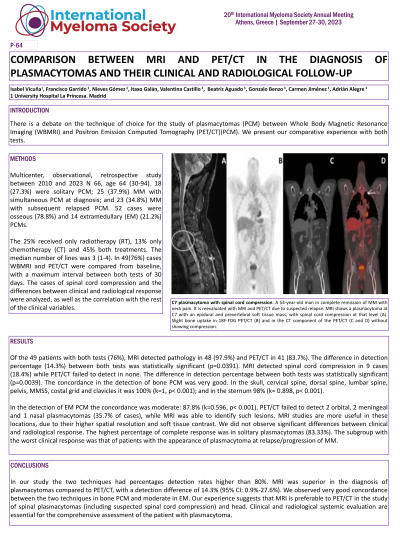Imaging and Management of Myeloma Bone Disease
Poster Session 1
P-064: COMPARISON BETWEEN MRI AND PET/CT IN THE DIAGNOSIS OF PLASMACYTOMAS AND THEIR CLINICAL AND RADIOLOGICLA FOLLOW-UP
Wednesday, September 27, 2023
1:30 PM - 2:30 PM EEST

.jpg)
Isabel Vicuna, PhD (she/her/hers)
hematologist
Hospital de La Princesa
Madrid, Spain
Introduction: There is a debate on the technique of choice for the study of plasmacytomas (PCM) between Whole Body Magnetic Resonance Imaging (WBMRI) and Positron Emission Computed Tomography (PET/CT)(PCM). We present our comparative experience with both tests.
Methods: Multicenter, observational, retrospective study between 2010 and 2023 N 66, age 64 (30-94). 18 (27.3%) were solitary PCM; 25 (37.9%) MM with simultaneous PCM at diagnosis; and 23 (34.8%) MM with subsequent relapsed PCM. 52 cases were osseous (78.8%) and 14 extramedullary (EM) (21.2%) PCMs. The 25% received only radiotherapy (RT), 13% only chemotherapy (CT) and 45% both treatments. The median number of lines was 3 (1-4). In 49(76%) cases WBMRI and PET/CT were compared from baseline, with a maximum interval between both tests of 30 days. The cases of spinal cord compression and the differences between clinical and radiological response were analyzed, as well as the correlation with the rest of the clinical variables.
Results: Of the 49 patients with both tests (76%), MRI detected pathology in 48 (97.9%) and PET/CT in 41 (83.7%). The difference in detection percentage (14.3%) between both tests was statistically significant (p=0.0391). MRI detected spinal cord compression in 9 cases (18.4%) while PET/CT failed to detect in none. The difference in detection percentage between both tests was statistically significant (p=0.0039). The concordance in the detection of bone PCM was very good. In the skull, cervical spine, dorsal spine, lumbar spine, pelvis, MMSS, costal grid and clavicles it was 100% (k=1, p< 0.001); and in the sternum 98% (k= 0.898, p< 0.001). In the detection of EM PCM the concordance was moderate: 87.8% (k=0.596, p< 0.001). PET/CT failed to detect 2 orbital, 2 meningeal and 1 nasal plasmacytomas (35.7% of cases), while MRI was able to identify such lesions. MRI studies are more useful in these locations, due to their higher spatial resolution and soft tissue contrast. We did not observe significant differences between clinical and radiological response. The highest percentage of complete response was in solitary plasmacytomas (83.33%). The subgroup with the worst clinical response was that of patients with the appearance of plasmacytoma at relapse/progression of MM
Conclusions: In our study the two techniques had percentages detection rates higher than 80%. MRI was superior in the diagnosis of plasmacytomas compared to PET/CT, with a detection difference of 14.3% (95% CI: 0.9%-27.6%). We observed very good concordance between the two techniques in bone PCM and moderate in EM. Our experience suggests that MRI is preferable to PET/CT in the study of spinal plasmacytomas (including suspected spinal cord compression) and head. Clinical and radiological systemic evaluation are essential for the comprehensive assessment of the patient with plasmacytoma.
Methods: Multicenter, observational, retrospective study between 2010 and 2023 N 66, age 64 (30-94). 18 (27.3%) were solitary PCM; 25 (37.9%) MM with simultaneous PCM at diagnosis; and 23 (34.8%) MM with subsequent relapsed PCM. 52 cases were osseous (78.8%) and 14 extramedullary (EM) (21.2%) PCMs. The 25% received only radiotherapy (RT), 13% only chemotherapy (CT) and 45% both treatments. The median number of lines was 3 (1-4). In 49(76%) cases WBMRI and PET/CT were compared from baseline, with a maximum interval between both tests of 30 days. The cases of spinal cord compression and the differences between clinical and radiological response were analyzed, as well as the correlation with the rest of the clinical variables.
Results: Of the 49 patients with both tests (76%), MRI detected pathology in 48 (97.9%) and PET/CT in 41 (83.7%). The difference in detection percentage (14.3%) between both tests was statistically significant (p=0.0391). MRI detected spinal cord compression in 9 cases (18.4%) while PET/CT failed to detect in none. The difference in detection percentage between both tests was statistically significant (p=0.0039). The concordance in the detection of bone PCM was very good. In the skull, cervical spine, dorsal spine, lumbar spine, pelvis, MMSS, costal grid and clavicles it was 100% (k=1, p< 0.001); and in the sternum 98% (k= 0.898, p< 0.001). In the detection of EM PCM the concordance was moderate: 87.8% (k=0.596, p< 0.001). PET/CT failed to detect 2 orbital, 2 meningeal and 1 nasal plasmacytomas (35.7% of cases), while MRI was able to identify such lesions. MRI studies are more useful in these locations, due to their higher spatial resolution and soft tissue contrast. We did not observe significant differences between clinical and radiological response. The highest percentage of complete response was in solitary plasmacytomas (83.33%). The subgroup with the worst clinical response was that of patients with the appearance of plasmacytoma at relapse/progression of MM
Conclusions: In our study the two techniques had percentages detection rates higher than 80%. MRI was superior in the diagnosis of plasmacytomas compared to PET/CT, with a detection difference of 14.3% (95% CI: 0.9%-27.6%). We observed very good concordance between the two techniques in bone PCM and moderate in EM. Our experience suggests that MRI is preferable to PET/CT in the study of spinal plasmacytomas (including suspected spinal cord compression) and head. Clinical and radiological systemic evaluation are essential for the comprehensive assessment of the patient with plasmacytoma.
